National dish
A national dish is a culinary dish that is strongly associated with a particular country.[1] A dish can be considered a national dish for a variety of reasons:
- It is a staple food, made from a selection of locally available foodstuffs that can be prepared in a distinctive way, such as fruits de mer, served along the west coast of France.[1]
- It contains a particular 'exotic' ingredient that is produced locally, such as the South American paprika grown in the European Pyrenees.[1]
- It is served as a festive culinary tradition that forms part of a cultural heritage—for example, barbecues at summer camp or fondue at dinner parties—or as part of a religious practice, such as Korban Pesach or Iftar celebrations.[1]
- It has been promoted as a national dish, by the country itself, such as the promotion of fondue as a national dish of Switzerland by the Swiss Cheese Union (Schweizerische Käseunion) in the 1930s.
National dishes are part of a nation's identity and self-image.[2] During the age of European empire-building, nations would develop a national cuisine to distinguish themselves from their rivals.[3]
According to Zilkia Janer, a lecturer on Latin American culture at Hofstra University, it is impossible to choose a single national dish, even unofficially, for countries such as Mexico, China or India because of their diverse ethnic populations and cultures.[2] The cuisine of such countries simply cannot be represented by any single national dish. Furthermore, because national dishes are so interwoven into a nation's sense of identity, strong emotions and conflicts can arise when trying to choose a country's national dish.
Latin American dishes
In Latin America, dishes may be claimed or designated as a "plato nacional", although in many cases, recipes transcend national borders with only minor variations. Both Peru and Ecuador claim ceviche as their national dish. Stews of meat, plantains, and root vegetables are the platos nacionales of several countries in Central America, South America, and the Caribbean: Colombian ajiaco, as well as the sancocho of the Dominican Republic, Colombia, and Panama, are examples of platos nacionales. Janer (2008) observes that this sharing of the same plato nacional by different countries calls into question the idea that every country has a unique national dish that is special to that country; she states that cuisine does not respect national and geopolitical borders.[2]
The identification of Latin American national dishes is stronger among expatriate communities in North America.[2] In Latin American countries, the plato nacional[4] is usually part of the cuisine of rural and peasant communities, and not necessarily part of the everyday cuisine of city dwellers. In expatriate communities, the dish is strongly reclaimed in order to retain the sense of national identity and ties to one's homeland, and is proudly served in homes and restaurants. By this show of national identity, the community can resist social pressures that push for homogenization of many ethnically and culturally diverse communities into a single all-encompassing group identity, such as Latino or Hispanic American.[2]
By country
This is not a definitive list of national dishes, but rather a list of some foods that have been suggested to be national dishes.
A
B
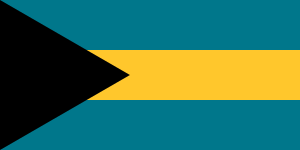


.svg.png)




C
D
E
G
I
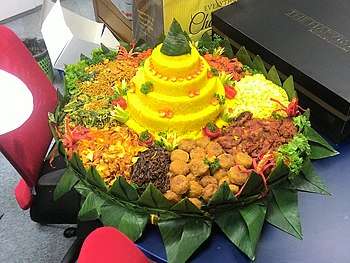





J
K
L
M
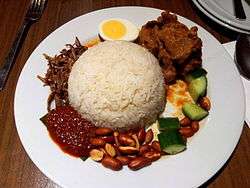



N

O
P
.jpg)

Q
R
S








T
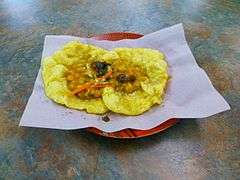
U
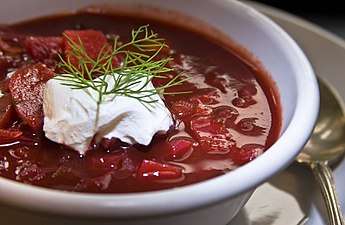





.svg.png)
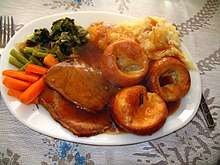
Gallery
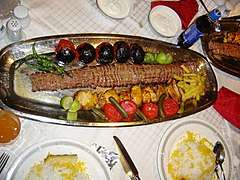 Chelo kabab, a national dish of Iran
Chelo kabab, a national dish of Iran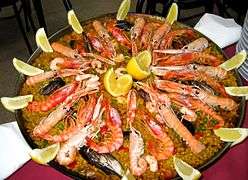 Seafood paella, Valencia, Spain
Seafood paella, Valencia, Spain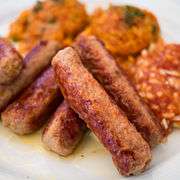 Croatian Ćevapčići
Croatian Ćevapčići- Phở - Vietnamese noodle soup, considered a Vietnamese national dish
- Russian pirozhki
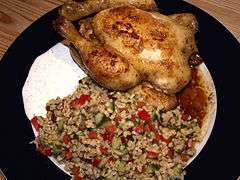 Tabbouleh served with chicken, Lebanon
Tabbouleh served with chicken, Lebanon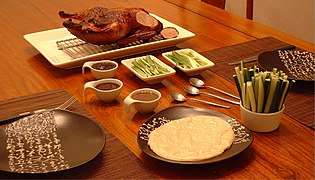 Peking duck, China
Peking duck, China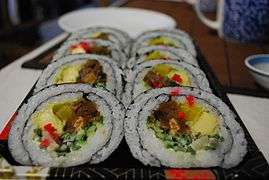 Sushi, Japan
Sushi, Japan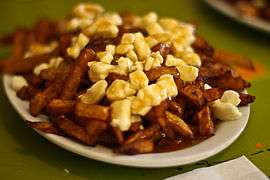 Poutine, considered one of the national dishes of Canada
Poutine, considered one of the national dishes of Canada- Thieboudienne, Senegal national meal
 Pilaf (O'sh), a national dish in the cuisines of Central Asia
Pilaf (O'sh), a national dish in the cuisines of Central Asia
Drink
National drinks
A national drink is a distinct beverage that is strongly associated with a particular country, and can be part of their national identity and self-image. National drinks fall into two categories, alcoholic and non-alcoholic. An alcoholic national drink is sometimes a national liquor drank straight/neat (as in the case of whiskey in Ireland), but is most often a mixed drink (e.g., caipirinhas in Brazil and pisco sours in Peru and Chile), or beer or wine. Examples of non-alcoholic national drinks include tea for China, Coca-Cola for the US, lassis for India, mate for Uruguay, and kompot for East European nations.
References
- "Top Ten National Dishes". National Geographic Magazine (Travel section). 2011-09-13. Retrieved 6 March 2013.
- Zilkia Janer (2008). Latino food culture. Food cultures in America. ABC-CLIO. pp. 71–73. ISBN 9780313340277.
- Howes, David; Lalonde, Marc (June 1991). "The history of sensibilities: Of the standard of taste in mid-eighteenth century England and the circulation of smells in post-revolutionary France". Dialectical Anthropology. 16 (2): 125–135. doi:10.1007/BF00250241. ISSN 0304-4092.
- online, testing (12 December 1990). "plato nacional". spanishdict.
- "Kabuli Pulao With Raisins And Carrots". Retrieved 15 August 2011.
- Stein, Rick. "Albanian baked lamb with rice (Tavë kosi)". BBC. Retrieved 24 June 2020.
- https://sites.google.com/site/albaninanfood/home/flija
- "Food in Algeria: Algerian Food, Algerian Cuisine". Retrieved 15 August 2011.
- Hamilton, Cherie. Cuisines of Portuguese Encounters New York: Hippocrene Books, 2001. p. 219
- "El asado". Archived from the original on 3 December 2013. Retrieved 25 February 2012.
- Symons, Michael (15 April 2010). "The confection of a nation the social invention and social construction of the Pavlova". Social Semiotics. 20 (2): 197. doi:10.1080/10350330903566004. Retrieved 25 November 2019.
- "Cautious change to Australia's 'national dish'". 2009-06-14. Retrieved 23 September 2018.
- "Our greatest Aussie recipes". Retrieved 5 June 2011.
- Harland, Robert. "Aussie meat pies". SunStar. Retrieved 24 June 2020.
- News Limited http://www.news.com.au/national/roast-lamb-rules-as-australias-national-dish/story-e6frfkvr-1225825752497
- "National Dishes & Local Favorites from the Islands of the Caribbean". Caribbeanamericanfoods.com. Archived from the original on 22 June 2010. Retrieved 4 July 2010.
- Bahrain's National Dish Archived 2011-06-10 at the Wayback Machine
- "A Bengali bounty". Retrieved 4 June 2011.
- Tom Masters (1 October 2009). Europe on a Shoestring. Lonely planet. ISBN 978-1-74104-855-1. Retrieved 15 July 2010.
- "The History of the Belgian Waffle, Which We've Apparently Been Eating All Wrong". 2015-02-02.
- "Bosanksi Lonac – Bosnia & Herzegovina National Dish". Archived from the original on 18 November 2010. Retrieved 18 September 2010.
- Rodrigo, Elias. "Feijoada: a short history of an edible institution" (PDF). Retrieved 5 July 2019.
- Bahrum Ali (21 February 2009). "Fostering family ties with ambuyat feasts". The Brunei Times. Archived from the original on 4 April 2014. Retrieved 5 April 2014.
- Jessica Tiah (8 January 2011). "Ambuyat - Our iconic heritage". The Brunei Times. Archived from the original on 4 April 2014. Retrieved 5 April 2014.
- "Khmer Foods". Tourism Cambodia. Retrieved 23 June 2020.
- "Cambodian Food Guide: Everything You Need To Know". Intrepid Travel. Retrieved 23 June 2020.
- "Khmer Foods". Tourism of Cambodia. Retrieved 8 August 2014.
- "Cambodia Food and Drink". Asiaview. Retrieved 8 August 2014.
- Trillin, Calvin (23 November 2009). "Canadian Journal, "Funny Food,"". The New Yorker: 68–70.
- Wong, Grace (2 October 2010). "Canada's national dish: 740 calories -- and worth every bite?". CNN. Archived from the original on 30 January 2011. Cite journal requires
|journal=(help) - Sufrin, Jon (22 April 2010). "Is poutine Canada's national food? Two arguments for, two against". Toronto Life. Archived from the original on 22 March 2011.
- O'Neil, Lauren (28 June 2012). "The CBC Community chooses Canada's most iconic food". CBC. Cite journal requires
|journal=(help) - Baird, Elizabeth (30 June 2009). "Does Canada Have a National Dish?". Canadian Living.
- DeMONTIS, RITA (21 June 2010). "Canadians butter up to this tart". Toronto Sun., Nanaimo Bar, Tourtière
- Florence Fabricant (14 April 2009). "For Chileans, Passion Translates to Empanadas". New York Times. Retrieved 12 March 2014.
- The South American Table by Maria Baez Kijac (ISBN 978-1-55832-249-3), page 208
- Rick Lundstrom (31 December 2013). "Classic duck dish now on Air China".
- Mary Bai (27 September 2011). "Peking Roast Duck, China's National Food". Archived from the original on 12 March 2014.
- "Top Five Macanese Dihes". Archived from the original on 2011-10-01.
- "POBREZA, DESARROLLO Y SALUD|1999-12-01". Retrieved 2 February 2011.
- "The Independent - 404". The Independent. Retrieved 17 April 2015.
- "Official results page of the Danish national dish competition". The Danish ministry of food. 20 November 2014. Archived from the original on 18 October 2014. Retrieved 21 November 2014.
- https://dominicanewsonline.com/news/homepage/news/general/breaking-news-callaloo-dominicas-new-national-dish/
- "El Encebollado | Montañita - Ecuador". Montanita.com. 9 May 2012. Retrieved 3 October 2013.
- "la guatita ecuatoriana". 19 December 2008. Retrieved 3 October 2013.
- "Food in Egypt". Retrieved 15 August 2011.
- Orson, Lucy (2 July 2000). "192-Part Guide To The World: Eritrea". The Independent. London. Retrieved 15 August 2011.
- "Food in Ethiopia". Retrieved 15 August 2011.
- "National dish of Finland". National-food.info. Archived from the original on 21 December 2016. Retrieved 17 September 2014.
- "Four Nations Where Forks Do Knives' Work". New York Times. 18 February 2004. Retrieved 6 July 2011.
- "Food Journeys of a Lifetime: Top Ten Great National Dishes". Away.com. Archived from the original on 17 January 2013. Retrieved 3 October 2013.
- "Famous French Food". Classic French Food. Archived from the original on 30 May 2019. Retrieved 7 July 2010.
- "Oiling the Wheels of the Economy." Gabon. Winter 2007. p. 19. Retrieved 10 March 2009 Archived 6 October 2011 at the Wayback Machine
- "What's On The Menu?: Germany's Favorite Dishes". German Foods. Archived from the original on 7 July 2010. Retrieved 8 July 2010.
- "Moussaka: The National Dish of Greece". Greecelogue. 2007-12-30. Retrieved 8 July 2010.
- "Top 10 National Dishes". Terrific Top 10. 2012-02-27. Retrieved 17 April 2015.
- Λεξικό της κοινής Νεοελληνικής, 1998
- "Oil down: National Dish of Grenada". Gov.gd. 5 March 2010. Retrieved 3 October 2013.
- "Khichdi not national food, clarifies Harsimrat Kaur Badal". THE HINDU.
- "It is a Cooked Up Story, Khichdi Will Not be Made National Dish: Harsimrat Kaur Badal". NEWS18.
- Media, Kompas Cyber. "Kemenpar Tetapkan 5 Makanan Nasional Indonesia, Ini Daftarnya - Kompas.com". KOMPAS.com (in Indonesian). Retrieved 2018-04-18.
- "A Soto Crawl". Eating Asia. Retrieved 5 July 2010.
- Sara Schonhardt and Melanie Wood (15 August 2011). "40 of Indonesia's best dishes". CNN Travel. Retrieved 6 July 2014.
- Chef Daeng. "Satay Washington DC". satay.com. Retrieved 6 July 2014.
- Nadya Natahadibrata (10 February 2014). "Celebratory rice cone dish to represent the archipelago". The Jakarta Post. Retrieved 9 July 2014.
- "Chelo Kebab Recipe, Middle Eastern food". About.com. Retrieved 7 July 2010.
- Beeston, Richard (27 June 2007). "Imams put fatwa on carp caught in Tigris". The Times. London. Retrieved 11 July 2010.
- accessdate=2010-07-15 Archived 31 January 2016 at the Wayback Machine
- McDonald, Brian (2008-05-12). "Top breakfast baguette rolls into Irish history". Irish Independent. Retrieved 2019-02-03.
- "Italy urged to go on pasta strike". BBC. 13 September 2007. Retrieved 8 July 2010.
- "Polenta". Retrieved 5 June 2011.
- "Food Journeys of a Lifetime: Top Ten Great National Dishes". Away.com. 9 October 2010. Archived from the original on 21 January 2011. Retrieved 3 October 2013.
- "Traditional Dishes of Japan". Japan National Tourism Organization. Retrieved 24 June 2014.
- 『カレーライス』に関するアンケート (in Japanese). ネットリサーチ ディムスドライブ. Retrieved 16 October 2008.
- McCurry, Justin (18 June 2010). "Ramen: Japan's super slurpy noodles". The Guardian. London. Retrieved 5 June 2011.
- "Jordan National Dish, Mansaf: Waleg Kitchen". Waleg.com. Archived from the original on 26 July 2017. Retrieved 3 October 2013.
- Business Optimization Consultants B.O.C. "Jordan: Jordanian Cuisine". Kinghussein.gov.jo. Retrieved 3 October 2013.
- Parkinson, Tom; Phillips, Matt; Gourlay, Will (2006). Kenya. ISBN 9781740597432.
- Williamson, Lucy (4 February 2014). "Kimchi: South Korea's efforts to boost its national dish". BBC News. Retrieved 20 May 2017.
Ku, Robert Ji-Song (31 December 2013). Dubious Gastronomy: The Cultural Politics of Eating Asian in the USA. University of Hawaii Press. p. 6. ISBN 978-0-8248-3921-5. - Govender, Serusha (6 May 2014). "10 National Dishes Around the World". The Daily Meal. Retrieved 20 May 2017.
- Jeffery, Nicole (20 May 2017). "Pyeongchang Winter Olympics: the next cool spot". The Australian. Retrieved 20 May 2017.
- Web Desk (7 February 2017). "National Dishes of the World". PKKH. Retrieved 20 May 2017.
- "Thailand". Encyclopedia Britannica. Retrieved 17 April 2015.
- Stokes, Daniel. 2003. Low language in high places: social and political perspectives on grammar in the prose of 'Rong Wongsawan'. Thesis (M.A.)--University of Wisconsin--Madison, 2003. P.38
- Burke, Andrew, and Austin Bush. "Eating." Bangkok: city guide. 9th ed. Footscray, Vic.: Lonely Planet, 2010. 157. Print
- "About Thai food". tourismthailand.org. Archived from the original on 9 June 2014. Retrieved 17 April 2015.
- Clements, Miles (28 October 2010). "The Find: Tom Yum Koong". Los Angeles Times.
- "A Taste of Sticky Rice, Laos' National Dish | Travel | Smithsonian Magazine". Smithsonianmag.com. Retrieved 3 October 2013.
- "The national dish of Lebanon". Sourat.com. Archived from the original on 13 September 2012. Retrieved 3 October 2013.
- "Judd mat Gaardebounen" Archived 2018-07-28 at the Wayback Machine, Mycitycuisine.org. Retrieved 30 November 2011.
- Boissard, Pierre (1997). Cuisine Malgache, Cuisine Creole. Antananarivo: Librairie de Tananarive. pp. 36–40.
- Dwayne A. Rules (7 April 2011). "Nasi lemak, our 'national dish'". The Star. Archived from the original on 2 July 2014. Retrieved 6 November 2013.
- "Mole Poblano: Mexico's National Food Dish". Mexonline. Retrieved 11 July 2010.
- Nina Terrero (11 September 2012). "How to make: Traditional Mexican favorites". NBC Latino.
- "Montenegro Crna Gora Montenegro". Montenegro.org.au. Retrieved 3 October 2013.
- "Food in Morocco - Moroccan Food, Moroccan Cuisine - popular, dishes, recipe, diet, history, common, meals, staple, rice, famous, main, people, favorite, make, customs, fruits, country, bread, vegetables, bread". foodbycountry.com. Retrieved 17 April 2015.
- "DAL BHAT". Retrieved 11 July 2010.
- "Bacon & Egg Pie". Archived from the original on 23 March 2016. Retrieved 5 June 2011.
- "Tender, loving care for lamb". Retrieved 5 June 2011.
- "'Fårikål' wins again as Norway's national dish". Newsinenglish.no. Retrieved 22 June 2020.
- "Norway sticks with fårikål as national dish". Thelocal.no. 17 June 2014. Retrieved 22 June 2020.
- "How to make Egusi soup". Retrieved 18 January 2016.
- "Beef Nihari". Retrieved 11 July 2010.
- "Ceviche – the Peruvian national dish". Peru Travel Guide. Archived from the original on 7 June 2008. Retrieved 11 July 2010.
- Bueno, Anna (21 June 2017). "Adobo, sinigang, or sisig: What's your pick for the Philippines' national dish?". CNN Philippines. Retrieved 26 December 2019.
- Gonzalez, Manny (12 July 2018). "Why don't we have official national dishes?". The Philippine Star. Retrieved 26 December 2019.
- Gapultos, Marvin (23 April 2013). The Adobo Road Cookbook: A Filipino Food Journey. Tuttle Publishing. p. 210. ISBN 978-1-4629-1169-1.
- DeWitt, Dave (2010). 1,001 Best Hot and Spicy Recipes. Agate Publishing. p. 428. ISBN 9781572841130.
Deere, Kiki (20 June 2017). Journey Through the Philippines: An Unforgettable Journey from Manila to Mindanao. Tuttle Publishing. p. 43. ISBN 978-1-4629-1886-7.
Sifton, Sam (5 January 2011). "The Cheat: The Adobo Experiment". The New York Times. Retrieved 5 June 2011.
Dee, Ching (3 September 2019). "Your Foodie Guide To Manila". Forbes Travel Guide. The Five Star Travel Corporation. Retrieved 26 December 2019.
Villafuerte, Sai (16 September 2019). "Filipino Chefs Are Taking Back Control of Their Cuisine". Vice. Retrieved 26 December 2019. - Vicky B. Bartlet (17 December 2011). "Palmonas: Make 'buko' juice as national drink". Business Mirror. Archived from the original on 10 January 2012. Retrieved 26 January 2012.
In his House Resolution 1887, Agham (Science) Party-list Rep. Angelo Palmones said the Philippines has already a number of national symbols, such as narra as national tree, sampaguita as national flower, mango as national fruit, milkfish as national fish and lechon (roast pig) as national dish.
Minahan, James B. (23 December 2009). The Complete Guide to National Symbols and Emblems [2 volumes]. ABC-CLIO. p. 152. ISBN 978-0-313-34497-8.
Geis, Darlene (1961). A Colorslide Tour of the Philippines: Island Democracy : Bright Garden of the Pacific. Columbia Record Club. p. 11.
Chan, Bernice (31 August 2017). "The secrets to great lechon - whole roasted suckling pig that's virtually a Filipino national dish". South China Morning Post. Hong Kong. Retrieved 14 December 2019.
Winn, Patrick (20 December 2012). "Philippines: New Year's Eve Lechon". Public Radio International. Minneapolis. Retrieved 14 December 2019.
Goodman, Vivian (26 December 2014). "Filipino community enjoys a taste of home in Akron". WKSU. Kent State University. Retrieved 14 December 2019.
Gardiner, Michael A. (11 December 2017). "Pork fat rules at Porky's Lechon". San Diego City Beat. United States. Retrieved 14 December 2019.
Gutman, David (15 October 2019). "Craving Filipino-style whole roast pig? Here's the place for you". Seattle Times. United States. Retrieved 26 December 2019. - "Try These Innovative Sisig Dishes That Might Just Win a National Competition". Pepper. Philippines. 18 September 2018. Retrieved 26 December 2019.
Fecks, Noah; Wagtouicz, Paul (29 October 2013). The Way We Ate: 100 Chefs Celebrate a Century at the American Table. Simon and Schuster. p. 154. ISBN 978-1-4767-3272-5. - McKinnon, Leila (1 November 2012). Australia's Favourite Recipes. Pan Macmillan Australia. p. 76. ISBN 978-1-74334-955-7.
Stafford, Paul (20 August 2018). "Like A Local: 10 Of The Most Unique Foods Of The Philippines". Travel Magazine. Retrieved 26 December 2019. - Helena Szymanderska. Polska wigilia. 2000
- "Kapusta kiszona (sauerkraut) is the basis for Poland's national dish bigos (sauerkraut with a variety of meats), kapuśniak (sauerkraut soup)" [in:] Polish Holiday Cookery by Robert Strybel, 2003, p. 14; "Bigos, the national dish of Poland — a hunter's stew of mixed meats and vegetables" [in:] The food lover's companion to Portland by Lisa Shara Hall, Roger J. Porter, 1996
- "Two national specialities you'll find everywhere are bigos (cabbage stewed with meat and spices) and pierogi" [in:] Poland: the rough guide, 1991 and kotlet schabowy is a close cousin of the Teutonic Wiener Schnitzel" [in:] Joey Porcelli, Clay Fong . The Gyros Journey: Affordable Ethnic Eateries Along the Front Range, 2006
- Alison Mutler (17 February 2014). "EU agrees to open its grills to Romania's national sausage". Vancouver Sun. Archived from the original on 19 May 2014.
- Groundwater, Ben (February 5, 2017). "Feed the World". Sydney Sun Herald. ProQuest 1864945067.
Beetroot soup: it may not sound that enticing, and it certainly doesn't look it. But imagine it's freezing cold outside, that the snow has been piling up for months. Imagine that a pot of soup has been sitting on the stove all day, improving and intensifying. Imagine that the best root vegetables have gone in there, plus herbs, and maybe hunks of sausage. Imagine that a steaming bowl is placed in front of you, topped with a dollop of sour cream. Now you're getting why this is Russia's favourite dish.
- Food in Motion: The Migration of Foodstuffs and Cookery Techniques : Proceedings : Oxford Symposium 1983. Oxford Symposium. 1983. p. 62. ISBN 978-0-907325-16-1.
- Леонид Беловинский. Энциклопедический словарь российской жизни и истории: XVIII-начало XX в., стр. 557, Пирог (Leonid Belovinskiy. The encyclopedic dictionary of Russian life and history: from the 18th to the beginning of the 20th centurym p. 557, "Pirog"; in Russian)
- Вильям Похлебкин. Большая энциклопедия кулинарного искусства, Пироги русские. Москва: Центрполиграф, 2010, ISBN 978-5-9524-4620-5 (William Pokhlyobkin. The Great Encyclopedia of Culinary Art, "Russian pirogi". Moscow: Centrpoligraph, 2010; in Russian)
- Encyclopedia Britannica (2002). The New Encyclopedia Britannica. 1. Encyclopedia Britannica. ISBN 978-0-85229-787-2.
- Ember, Melvin (2001). Countries and Their Cultures: Saint Kitts and Nevis to Zimbabwe. p. 68. ISBN 9780028649467.
- "Serbian cuisine". TravelSerbia. Retrieved 9 August 2010.
- Laurence Mitchell (2010). Serbia. Bradt Travel Guides. p. 79. ISBN 978-1-84162-326-9.
- Pamela Goyan Kittler; Kathryn P. Sucher; Marcia Nahikian-Nelms (August 2011). Food and Culture, 6th ed. Cengage Learning. p. 410. ISBN 978-0-538-73497-4.
Large, thin meat patties made from lamb and beef, known as pljeskavica, are considered a national dish of Serbia but are also a favorite with Bosnians and Croatians
- "Gibanica, a pie like no other". serbia.com. Retrieved 21 March 2013.
- "Fall Brings Red Peppers and Ajvar, 'Serbian Salsa'". NPR. 8 November 2006.
- Peta Lyn Farwagi (August 1978). Full of beans. Harper & Row. p. 160. ISBN 978-0-06-090601-6.
- "The quest for Singapore's next national dish". CNN. 26 January 2010. Archived from the original on 14 June 2012. Retrieved 7 July 2010.
- Kugiya, Hugo (18 March 2010). "Singapore's national dish: Hainan chicken rice". Crosscut.com. Archived from the original on 31 August 2011. Retrieved 3 October 2013.
- "National Food". Slovak Republic. Retrieved 1 August 2010.
- Crais, C.; McClendon, T.V. (2013). The South Africa Reader: History, Culture, Politics. The World Readers. Duke University Press. p. 64. ISBN 978-0-8223-7745-0.
- Kronenthal, Melissa (1 May 2010). "Spain's tortilla de patatas is simply satisfying". The Seattle Times. Retrieved 18 May 2011.
- "Sri Lanka Food Rice & Curry". Retrieved 18 May 2011.
- "Food and Drink in Sweden: Sweden Travel Guide". Swedentravelnet.com. Archived from the original on 16 November 2018. Retrieved 3 October 2013.
- "The crayfish party". Sweden.Se. Retrieved 3 October 2013.
- BBC http://news.bbc.co.uk/2/hi/europe/4867024.stm
- Cederling: Surströmming (Rotten or more like sour herring) Archived 14 July 2011 at the Wayback Machine
- John Tagliabue (3 February 2008). "Swiss Sausage Fans Fret Over How to Save Their Skin". The New York Times.
- "Tanzania: 3 FOODS OF THE TANZANIANS". Advameg, Inc. Retrieved 25 March 2013.
- "Typical Thai Meals & Eating Habits". Bangkok.com. Retrieved 7 July 2010.
- "National Dishes & Local Favorites from the Islands of the Caribbean". Caribbeanamericanfoods.com. Archived from the original on 4 October 2013. Retrieved 3 October 2013.
- https://www.winemag.com/recipe/crab-and-dumplings-tobago/
- "NATIONAL DISHES OF THE WORLD - GUTSY GOURMET". thegutsygourmet.net. Retrieved 17 April 2015.
- Elizabeth Taviloglu. "Navy Bean Stew Is Turkey's National Dish". turkishfood.about.com. Retrieved 12 March 2014.
- Л. М. Безусенко (ред.) (2002), "Борщ", Українська нацiональна кухня, Сталкер, p. 31 (L. M. Bezussenko, ed. (2002), "Borscht", Ukrainian Ethnic Cuisine (in Ukrainian), Stalker Publishers, p. 31)
- В. В. Похлёбкин (2000), Кулинарный словарь от А до Я, Центрполиграф (William Pokhlyobkin (2000), "Borscht", The Culinary Dictionary from A to Z (in Russian), Centrpoligraf)
- Л. М. Безусенко (ред.) (2002), "Вареники", Українська нацiональна кухня, Сталкер (L. M. Bezussenko, ed. (2002), "Varenyky", Ukrainian Ethnic Cuisine (in Ukrainian), Stalker Publishers, p. 181)
- В. В. Похлёбкин (2000), "Вареники", Кулинарный словарь от А до Я, Центрполиграф, p. 181 (William Pokhlyobkin (2000), The Culinary Dictionary from A to Z (in Russian), Centrpoligraf)
- "Fish and Chips," in Fast Food and Junk Food: An Encyclopedia of What We Love to Eat (2011). Ed. Andrew F. Smith. ABC-CLIO p. 258 .
Darwin Porter and Danforth Prince, Frommer's England 2011: With Wales (2010). John Wiley & Sons: p. 163.
Heston Blumenthal, In Search of Total Perfection (2010). Bloomsbury: p. 205.
Fish and Chips, Historic UK.
Heston Blumenthal, Further Adventures in Search of Perfectionp. 100
Roy, Parama (2010). Alimentary Tracts: Appetites, Aversions, and the Postcolonial. Durham N.C.: Duke University Press. ISBN 9780822347880. p. 3 - Lemm, Elaine (5 May 2019). "The National Dishes of Britain and Ireland". The Spruce Eats. Retrieved 4 June 2019.
- Spencer, Colin (2003). British Food: An Extraordinary Thousand Years of History. Columbia University Press. ISBN 978-0-231-13110-0.
- Robert Appelbaum, Aguecheek's Beef, Belch's Hiccup, and Other Gastronomic Interjections: Literature, Culture, and Food Among the Early Moderns (2006). University of Chicago Press, p. 214
Yee Chiang, The Silent Traveller in London (1939). Interlink: p. 157. - Peter Earle. The Making of the English Middle Class: Business, Society and Family Life in London 1660-1730 (1989). University of California Press: p. 279.
Cassell's Dictionary of Cookery (1883), p. 137.
About Plum Pudding, Everyday Housekeeping: A Magazine for Practical Housekeepers and Mothers (Vol. 13-14), p. 97. - "Ireland: Ulster Fry (March 10, 2008)". European Cuisines. 10 March 2008. Retrieved 3 October 2013.
- Sari Edelstein. Food, Cuisine, and Cultural Competency for Culinary, Hospitality, and Nutrition Professionals (2010). Jones & Bartlett : p. 118.
Lesley Anne Rose, Michael Macaroon, and Vivienne Crow. Frommer's Scotland (2012). John Wiley & Sons: p. 28. - "Welsh national dish". Foodmuseum.com. Archived from the original on 15 July 2010. Retrieved 4 July 2010.
- Danny Walsh (5 July 2017). Recipes for Reminiscence: The Year in Food-Related Memories, Activities and Tastes. Taylor & Francis. p. 125. ISBN 978-1-351-70537-0.
- Crawford, Constance (1988). The Muse of Menus: Stories from Life and Cooking. J. Daniel. p. 113. ISBN 978-0-936784-64-9.
Raymond A. Sokolov (1998). Fading Feast: A Compendium of Disappearing American Regional Foods. David R. Godine. p. 13. ISBN 978-1-56792-037-6.
Mann, Bill (10 May 2012). "Will poutine become Canada's national dish?". MarketWatch. Vancouver. Retrieved 15 May 2020. - "Top 10 National Dishes". National Geographic. 13 September 2011. Retrieved 1 January 2020.
Eric Schlosser (2012). Fast Food Nation: The Dark Side of the All-American Meal. Houghton Mifflin Harcourt. pp. 197–199. ISBN 0-547-75033-1. - Mark Stewart (August 2016). The United States and Canada. Capstone. p. 40. ISBN 978-1-4846-3814-9.
- Smyth, Clifford (1924). The Literary Digest International Book Review. Funk and Wagnalls Company. p. 637.
Industrial Development and Manufacturers' Record. Conway Publications. 1917. p. 19. - George Frederick Scotson-Clark (1923). Eating Without Fears. N.L. Brown. p. 87.
- Trumbull, Robert (1977). "Two Samoas". Tin Roofs and Palm Trees (PDF). Australian National University Press. p. 196. ISBN 0708107443 – via Australian National University.
- Martinez, Lacee A.C. (19 May 2016). "Pucker up: Yigo to celebrate first citrus festival". Pacific Daily News. Guam. Retrieved 4 January 2020.
- Kramer, Hilary (24 August 2013). "Spam Is For Eating --- Not Deleting". Forbes. Retrieved 4 January 2020.
- Minahan, James B. (23 December 2009). The Complete Guide to National Symbols and Emblems [2 volumes]. ABC-CLIO. p. 139. ISBN 978-0-313-34497-8.
Wise, Naomi (10 March 2005). "Your Special Island". San Diego Reader. Retrieved 4 January 2020. - Squires, Kathleen (5 December 2014). "Where to Find the Best Roast Pork in Puerto Rico". The Wall Street Journal. New York City. Retrieved 14 February 2020.
Claiborne, Craig (5 July 1978). "A 'Casual' Dinner in Puerto Rico". The New York Times. Retrieved 14 February 2020.
Philpott, Don (28 February 2003). Landmark Puerto Rico. Landmark Publishing Limited. p. 28. ISBN 978-1-901522-34-1.
Ritschel, Chelsea (11 December 2019). "What Christmas Dinner Looks Like Around The World". Independent. United Kingdom. Retrieved 14 February 2020. - Mariano, Maureen Aimee (4 April 2016). "The Five Best Places for Mofongo in Maimi". Miami New Times. Retrieved 3 January 2020.
"Foods of Puerto Rico". American Indian Health and Diet Project. Kansas University. Retrieved 3 January 2020.Popular foods in Puerto Rico include the national dish, mofongo (below), made with fried and mashed plantains that are mixed with shrimp, bacon, olive oil and garlic.
Zaino, Caitlin (15 July 2013). "On the mofongo trail in Puerto Rico". Travel. BBC. Retrieved 3 January 2020.From urban Old San Juan to the beaches of Isla Verde, past the cities of Bayamón and Ponce, through lush rainforest and striking coastlines, mofongo proudly stands as Puerto Rico’s unofficial national dish.
Pitzer, Kurt (2 September 2009). Puerto Rico's Cordillera Central. Hunter Publishing, Inc. p. 24. ISBN 978-1-58843-796-9. - Minahan, James B. (23 December 2009). The Complete Guide to National Symbols and Emblems [2 volumes]. ABC-CLIO. p. 769. ISBN 978-0-313-34497-8.
Fodor's Travel Guides (10 October 2017). Fodor's U.S. & British Virgin Islands. Fodor's Travel. p. 124. ISBN 978-0-14-754695-1. - "Cuisine of Uzbekistan. Uzbek national dish :: Plov". Orexca.com. Retrieved 3 October 2013.
"Welcome to Uzbek National Cuisine!". Uzbekcuisine.com. Retrieved 3 October 2013. - "Venezuelan Cuisine: Vanezuelan National Dish (Pabellon Criollo Con Barandas)". Chowtimes.com. 22 May 2010. Retrieved 7 July 2010.
- "Pho: national dish, international obsession". Vietnews Online. 14 February 2010. Archived from the original on 1 March 2010. Retrieved 7 July 2010.
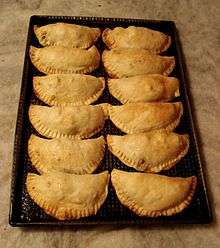
.jpg)